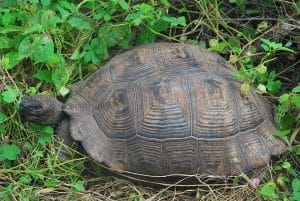Chelonoidis vicina (Isabela Island Giant Tortoise)
Home > Turtle Database > Chelonoidis vicina (Isabela Island Giant Tortoise)
Chelonoidis vicina is a species of giant tortoise native to the Galápagos Islands. These tortoises are notable for their large size and unique adaptations to different island environments. Chelonoidis vicina populations have been impacted by human activities but conservation efforts are underway to preserve them.
Native To These Regions
Isabela Island (Ecuador)Native Turtle Species Map – Find Turtles by Region
Scientific Classification
- Kingdom: Animalia
- Phylum: Chordata
- Class: Reptilia
- Order: Testudines
- Family: Testudinidae
- Genus: Chelonoidis
- Species: Chelonoidis vicina
Common Names
- Isabela Island Giant Tortoise
- Cerro Azul giant tortoise
- Iguana Cove tortoise
This Hilarious Turtle Book Might Know Your Pet Better Than You Do
Let’s be real—most turtle care guides feel like reading a textbook written by a sleep-deprived zookeeper.
This one’s not that.
Told from the snarky point of view of a grumpy, judgmental turtle, 21 Turtle Truths You’ll Never Read in a Care Guide is packed with sarcasm, sass, and surprisingly useful insights.
And hey—you don’t have to commit to the whole thing just yet.
Grab 2 free truths from the ebook and get a taste of what your turtle really thinks about your setup, your food choices, and that weird plastic palm tree.
It’s funny, it’s honest, and if you’ve ever owned a turtle who glares at you like you’re the problem—you’ll feel seen.
Identification
Description
Chelonoidis vicina can weigh up to 250 kg and have a shell length of around 150 cm. They have domed carapaces and robust, thick limbs adapted for terrestrial movement. Their shells vary slightly depending on the island of origin.
Sexual Dimorphism
Males tend to be larger than females, with longer tails and concave plastrons to assist during mating.
Check more turtles from the Chelonoidis genus
Native Origin and Distribution
Geographical Range
Chelonoidis vicina is found primarily on Isabela Island, specifically near Volcán Cerro Azul in the Galápagos Archipelago.
Preferred Habitat
This tortoise prefers dry, arid regions with sparse vegetation. They can also be found in volcanic areas with scrubland and open meadows for grazing.
Behavior
Feeding Habits
Chelonoidis vicina is primarily herbivorous, feeding on grasses, leaves, fruits, and cacti. They play an important role in seed dispersal within their habitat.
Predators
Adult tortoises have few natural predators due to their size and tough shells. However, hatchlings and eggs are vulnerable to introduced species such as rats and dogs.
Reproduction
Breeding Season
Breeding typically occurs during the rainy season, between January and August.
Reproductive Method
Females lay clutches of 2 to 16 eggs in nests dug in sandy soils. The eggs incubate for several months before hatching, with temperature influencing the sex of the hatchlings.
Conservation
Extinction Status
Chelonoidis vicina is listed as Vulnerable on the IUCN Red List due to habitat destruction and introduced predators.
Threats
Human activities, such as deforestation and the introduction of invasive species, pose significant threats to this species.
Conservation Measures
Conservation efforts include habitat protection, captive breeding programs, and the eradication of invasive species on the Galápagos Islands.
Economic Importance
Galápagos tortoises, including Chelonoidis vicina, are a major attraction for eco-tourism in the Galápagos, contributing significantly to the local economy.
Interesting Facts
- Chelonoidis vicina can live over 100 years in the wild.
- They have the ability to survive without food or water for extended periods, up to a year, due to their slow metabolism.

About Author
Muntaseer Rahman started keeping pet turtles back in 2013. He also owns the largest Turtle & Tortoise Facebook community in Bangladesh. These days he is mostly active on Facebook.















